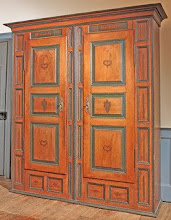I (Andrew) love Halloween. It's always been my favorite holiday. As an adult, it's because it's the epitome of fall--cool and colorful, and well, I also love horror flicks. As a kid, of course, it was the costumes. My mother was a real "Martha" when it came to Halloween costumes. Sure, I went as a vampire several years, but one year I also went as an octopus. Mom made me a costume that consisted of a hood/mask and eight stuffed and sewn arms. It was fabulous.
In 5th grade, I went as "The Generic Kid." White pants labeled "PANTS", white shirt labeled "SHIRT", well, you get the idea. See, I grew up in middle-class suburbia, so generic products (complete with white labels and plain black lettering: "GREEN BEANS") were a staple of life. We complained. We wanted Del Monte vegetables and Nike shoes. "No," my mother would say, "These are cheaper and they are just as good." In my whitebread world, my costume needed no explanation. In fact, it was the hit of the party.
Where am I going with this? Recently, we got an email from a faithful reader (thanks for reading!) who does not see a new generation of collectors (and, frankly, we're not sure we do either...be sure to read our next column). This reader suggests that the unique-ness of antiques confounds younger folks, and he may be right. We grew up in a big-box environment, where everything is the same. One TV is just as good as the next. So now, why would a 30-something think of anyplace other than a big-box store to purchase generic furnishings for their cookie-cutter house? Even if you are choosing between the $399 sofa and the $699 sofa, they both often look exactly the same. Not so with antiques, so many choices, so much variety, it jars the senses of those who are used to mass-produced, plain vanilla mediocrity. In the world of antiques, everything is different and nothing is "just as good."
How do we overcome this? Perhaps we need to completely overhaul our business model. In a recent opinion column in The New England Antiques Journal, John Fiske suggested looking to mainstream retailers and their sales and advertised discounts. It may feel weird to us in the trade who are use to bidding and haggling, but if we want new buyers, we may need to create an environment in which today’s retail buyers are comfortable. You might not like the idea, but having a “Everything 25% Off” banner in your booth might just draw in a few more buyers. It's worth a shot, isn't it?
(I do, take issue, dear reader, with your comment that all young people are all "cheapskates." We are not cheapskates, we are simply in debt. The average college graduate in 2010 begins their adult life with over $20,000 in student loan debt. I just paid off my undergraduate education this past summer...14 years after I graduated. Now, it's on to my grad school loans.)


2 comments:
Dealers on the retail level have already been discounting upon request to sell inventory - it has become almost mandatory over the last five years.
This is heavily due to the move away from antique forms by the design trade/design media which moves more and more heavily into modern, newly made forms each year. The demand in the mid-range antique market simply has been diminishing bit by bit over the last ten years.
While it is possible in more typical downturns, to discount heavily and make up the difference in volume to get through the downturn, one now also has to look at the bigger picture in terms of demand - what is wanted and where is the demand coming from?
Here are a few articles which address a few of these points -
http://www.theartnewspaper.com/articles/Will-the-pendulum-swing-back-to-traditional-art?/21654
http://www.theartnewspaper.com/articles/Americana+feels+the+slump+of+US+market/21566
To salvage what is left of the mid-range antiques market within the existing and future marketplace will likely require a re-branding or repackaging of the concept of them, which can seem like a daunting task.
It is possible to recreate an audience. From there, we could try to create collectors again - but at this point, it's come down to creating any sort of sustained demand at all.
You are spot on, and you'll see in our next column that we agree. We need to re-brand antiques, particularly the middle and lower end of the market, to generate interest by ANYONE. There simply will not be enough collectors the sustain the current market for another generation. We need buyers. Users. Decorators. Whatever. It is a daunting task, but it's easier than creating a generation of collectors if there is little money and interest.
Post a Comment